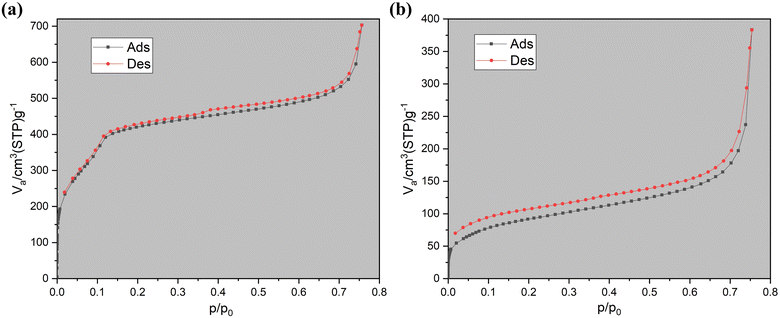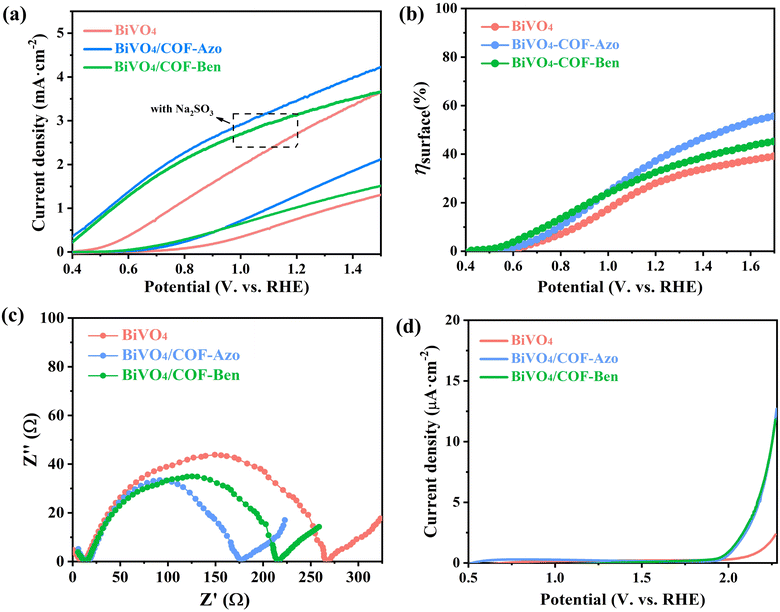 Open Access Article
Open Access ArticleModified photoanode by in situ growth of covalent organic frameworks on BiVO4 for oxygen evolution reaction†
Anni Guo‡
a,
Xingchun Wu‡a,
Syed Husnain Alia,
Huawei Shenc,
Ligong Chen *ab,
Yang Li
*ab,
Yang Li ab and
Bowei Wang
ab and
Bowei Wang *ab
*ab
aSchool of Chemical Engineering and Technology, Tianjin University, Tianjin 300350, P. R. China. E-mail: lgchen@tju.edu.cn; bwwang@tju.edu.cn
bInstitute of Shaoxing, Tianjin University, Shaoxing 312300, Zhejiang, P. R. China
cShaoxing Xingxin New Materials Co., Ltd, Shaoxing 312300, Zhejiang, P. R. China
First published on 22nd March 2024
Abstract
The development of efficient oxygen evolution reaction (OER) catalysts is of great significance because the water oxidation reaction at the photoanode is the rate-determining step in photoelectrocatalytic (PEC) water splitting. Herein, two hybrid photoanodes named BiVO4/COF-Azo and BiVO4/COF-Ben were prepared by in situ solvothermal growth on a modified BiVO4 photoanode. Characterization results revealed that the Azo and Ben COFs could match with BiVO4 well to form heterojunctions, which could effectively enhance the separation efficiency of photogenerated carriers. Also, the smaller impedance of the composite photoanodes and faster kinetics of the water oxidation reaction promoted the charge transmission and enhanced the reaction efficiency of the surface-reaching holes, respectively. As a result, the composite photoanodes exhibited a larger photocurrent and more negative onset potential compared to the pristine BiVO4. This work not only provides a new strategy to construct efficient hybrid photoanodes, but also expands the applications of COFs.
Introduction
With rapid industrialization and ever-increasing global population,1 environmental pollution and the energy crisis have become the most alarming concerns globally,2–4 which threaten the development and survival of living beings.5 The development of renewable energy sources such as solar, ocean6 and nuclear7 energy is thought to be one of the effective methods to solve them. Among them, photoelectrocatalytic (PEC) decomposition of water is an important technique to convert solar energy to chemical energy,8 which includes oxygen evolution reaction (OER) and hydrogen evolution reaction (HER).9 However, compared with HER, OER is the rate-determining step that governs the reaction rate of the PEC water splitting, owing to the multi-electron transfer reaction pathway.10,11 Furthermore, it is often accompanied by excessive reaction overpotential and poor reaction kinetics at the photoanode in the OER process,12,13 so improving the performance of OER is the key to improve the photoconversion efficiency.14 Therefore, designing and synthesizing efficient catalysts for OER is of uppermost priority.15,16Covalent organic frameworks (COFs), a class of porous nanomaterials with periodically tunable structures, can be used as a functional material with promising applications in environmental regulation and energy utilization.17,18 For example, they always combine the advantages of large specific surface area and ordered pore structure, which can provide more active sites and facilitate the mass transfer.19 Also, their π-conjugated skeleton as 2D materials endows them with an excellent ability to harvest light and conduct electrons. More importantly, formed by the stacking of molecular layers, COFs typically have columnar π-arrays that are beneficial for electron delocalization, further promoting the separation and migration of photogenerated carriers.20–22 Moreover, strong covalent bond linkages endow them with good chemical and thermal stabilities, which enables them to have a long lifetime. However, the fast charge recombination of most pure COFs results in their low photo- or electro-catalytic efficiency. Hence, considering that the tunable band structure of COFs can match with many inorganic semiconductors to form a built-in electric field, which is conducive to the separation of photogenerated holes and electrons, the hybridization of organic COFs and inorganic semiconductors may be a feasible strategy to boost the OER activity of photoanodes.23
Among inorganic semiconductors, bismuth vanadate (BiVO4) is recognized as a highly promising photoanode.24 First, its appropriate band gap (∼2.4 eV) allows solar light absorption and so it has the potential as a photocatalyst driven by visible light. Second, its moderate valence band (2.4 V vs. the reversible hydrogen electrode, RHE) matches the thermodynamic oxygen evolution potential well. Besides, its conduction band (∼0.0 V vs. RHE) provides a more negative photocurrent onset. Nevertheless, the application of BiVO4 is still impeded on account of the low separation capacity and high electron–hole recombination rate as well as poor charge transport.25 In this context, many modified strategies have been proposed, such as tuning the morphology, doping,26,27 incorporating cocatalysts28–30 and constructing heterojunctions.31–33 Especially a heterojunction photoanode is considered as an efficient method to increase optical absorption, promote charge separation and prolong carrier lifetime. Accordingly, combining the COFs mentioned above with BiVO4 to build a heterojunction photoanode may also be an effective way to enhance OER activity. However, to our best knowledge, there have been few reports on the hybridization of COFs and BiVO4 as effective photoanodes for photoelectrocatalytic OER.
Herein, BiVO4/COF-Azo and BiVO4/COF-Ben hybrid photoanodes were successfully prepared by an in situ solvothermal growth method (Scheme 1). Their structures and morphology were characterized by Fourier transform infrared (FT-IR) spectroscopy, scanning electron microscopy (SEM) and transmission electron microscopy (TEM). The phase compositions and surface chemical states were studied by powder X-ray diffraction (PXRD) analysis and X-ray photoelectron spectroscopy (XPS), respectively. Due to the change of light absorption ability and energy band structures, the OER performances of two hybrid photoanodes were improved compared to that of pristine BiVO4 photoanode. Furthermore, the corresponding catalytic mechanism was proposed.
Experimental section
Preparation of BiVO4 seed layer34
The BiVO4 seed layer was prepared on FTO conductive glass by the spin-coating method. Firstly, bismuth nitrate (485.1 mg) and ethylenediamine tetraacetic acid (438.4 mg) were dispersed in 15 mL ultrapure water. Then, ammonia solution (1 mL) was added to the solution to regulate pH to 10 and the mixture was stirred to be fully dissolved. The obtained solution was named solution A. Similarly, solution B was obtained by using ammonium metavanadate (117.0 mg) and ethylenediamine tetraacetic acid (146.1 mg) following the same above procedure. Mix up solution A and B evenly to yield the seed layer precursor. Secondly, the FTO conductive glass was placed on the spinner for spin-coating operation and dropped 10 drops of seed layer precursor solution, then were put in the muffle furnace at 500 °C for 3 min. Repeat the above operation for three times and take it out. Finally, the FTO conductive glass covered with BiVO4 seed layer was obtained by heat treatment in the muffle furnace at 500 °C for 2 h.Preparation of the BiVO4 photoanode
The BiVO4 photoanode was prepared by a seed layer-assisted hydrothermal method. Firstly, bismuth nitrate (145.5 mg) and ethylenediamine tetraacetic acid (131.5 mg) were dispersed in distilled water (30 mL). Subsequently, 2 M NaOH solution (0.75 mL) was dropped to adjust pH and the mixture was stirred to be dissolved completely. Next, ammonium metavanadate (35.1 mg) was added to the above solution with stirring. When it became yellow and transparent, pour it into a 50 mL Teflon-lined autoclave with the BiVO4 seed layer substrate leaning against the autoclave wall and the seed layer side facing down. The hydrothermal process was carried out at 180 °C for 3 h to obtain the BiVO4 photoanode. The reactor was cooled to room temperature and the glass was taken out with clean tweezers, washed with ultrapure water and dried in the blast drying oven. At last, the prepared photoanode was calcined at 500 °C for 4 h.Synthesis of the BiVO4/COF-Azo photoanode
The BiVO4/COF-Azo was prepared by in situ solvothermal growth method. Firstly, 0.2 mL γ-aminopropyltriethoxysilane was dissolved in 10 mL absolute ethanol and the prepared BiVO4 photoanode was immersed in it for 12 h, then taken out and dried to complete the amination modification process. Secondly, the aminated BiVO4 photoanode was placed into 5 mL N,N-dimethylacetamide (DMAc) solution dissolving 5 mg 1,3,5-triformylphloroglucinol at room temperature for 1 h. Then, 1,3,5-triformylphloroglucinol (21 mg, 0.1 mmol), 4,4′-azodianiline (32 mg, 0.15 mmol) and N,N-dimethylacetamide/o-dichlorobenzene (2 mL, 1/1 v/v) were added to a 10 mL Pyrex tube. The reactants were dispersed by ultrasonication for 10 min and then the above treated BiVO4 photoanode was put into the mixture. After being degassed through three freeze–pump–thaw cycles, the tubes were vacuum sealed and placed in an oven for 4 days at 120 °C. Finally, when cooled to room temperature after the reaction, the photoanode was taken out and the powders in the tube were filtered out. Then both were dried under vacuum at 80 °C for 12 h after being washed thoroughly with DMF, acetone and methanol.Synthesis of the BiVO4/COF-Ben photoanode
The prepared BiVO4 photoanode was immersed into 5 mL DMAc solution dissolving 5 mg 1,3,5-triformylphloroglucinol at room temperature for 1 h. 1,3,5-Triformylphloroglucinol (21 mg, 0.1 mmol), 4,4′-diamino-p-terphenyl (39 mg, 0.15 mmol) and dioxane/mesitylene (3 mL, 2/1 v/v) were added to a 10 mL Pyrex tube. The reactants were dispersed by ultrasonication for 10 min and then the above treated BiVO4 photoanode was put into the mixture. After being degassed through three freeze–pump–thaw cycles, the tubes were vacuum sealed and placed in an oven for 3 days at 150 °C. Finally, when cooled to room temperature after the reaction, the photoanode was taken out and the powders in the tube were filtered out. Then both were dried under vacuum at 80 °C for 12 h after being washed thoroughly with DMF, acetone and methanol.Results and discussion
Characterization of photoanodes
The morphologies of BiVO4 photoanode before and after modified by COF were examined by SEM and TEM. As can be seen from the SEM images (Fig. 1), pure BiVO4 photoanode was composed of nanoplate arrays with a thickness of approximately 250 nm, forming a thin film with a thickness of 1.4 μm on the FTO conductive glass. Their close contact was conducive to the rapid separation of photogenerated electrons and holes. After in situ growth of COF-Azo and COF-Ben, the pristine BiVO4 nanoplate morphology was maintained, but the aggregated particles uniformly covered the surface of nanoplate structure to make it rougher, indicating the successful integration of the COF layer. From the high-resolution TEM images (Fig. S1†), it exhibited obvious lattice fringes on the BiVO4 layer, indicating its high crystallinity with few intrinsic defects. The EDS mapping images showed that V, Bi, C, N and O were all uniformly distributed in BiVO4/COF-Azo and BiVO4/COF-Ben. However, the distribution ranges of N and C elements were a little bit larger than the other three elements, further demonstrating the uniform and complete coating by two COFs on the surface of BiVO4 nanoplates. Their close contact can effectively extract photo-induced holes from the semiconductor and promote the water oxidation reaction.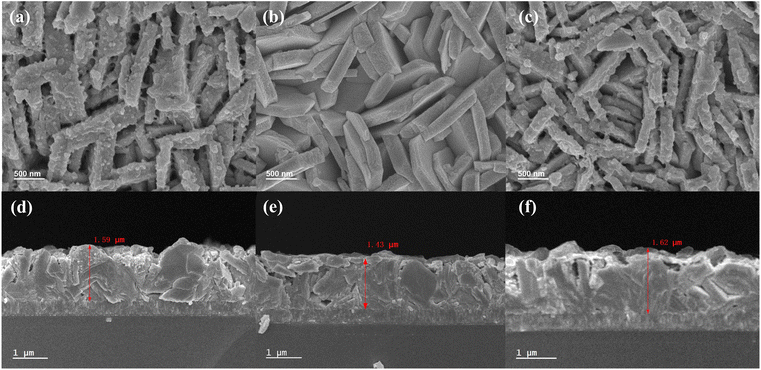 | ||
| Fig. 1 Zenithal SEM images of (a) BiVO4/COF-Azo, (b) BiVO4, (c) BiVO4/COF-Ben and cross-sectional SEM images of (d) BiVO4/COF-Azo, (e) BiVO4, (f) BiVO4/COF-Ben. | ||
Subsequently, the phase composition of the prepared photoanode was characterized by powder X-ray diffraction. There was a negligible difference between the XRD patterns of the two composite photoanodes and pure BiVO4 photoanode (Fig. S2†). They all displayed the diffraction peaks of FTO conductive glass and monoclinic scheelite of BiVO4, indicating that the composite of COF had no effect on the phase composition of the BiVO4 photoanode. However, compared with the standard PDF card (JCPDS No. 44-0081), there was no diffraction peak with 2θ of 30.5° in the XRD pattern of BiVO4, which corresponded to the (0 4 0) crystal plane. It implied that the growth of BiVO4 crystal in this direction was inhibited, which might also be the reason why BiVO4 crystal finally grew into nanosheets. In order to confirm the formation of crystalline COFs, the powders in Pyrex tube were collected by filtration and characterized by XRD (Fig. S3†). It was found that there was a main diffraction peak at 3.12° for COF-Azo and 2.72° for COF-Ben, respectively. In addition, the experimental PXRD patterns of the COFs were both highly consistent with the simulated stacking model. COFs with high crystallinity can improve the efficiency of mass transfer and make holes transfer to the surface of the photoanode quickly to participate in the OER. Furthermore, the structures of COF-Azo, COF-Ben and their corresponding composites with BiVO4 were confirmed by FT-IR spectroscopy (Fig. S4a†). It was shown that two new vibration peaks at 1618 cm−1 and 1577 cm−1 were observed in the spectra of COF-Azo and COF-Ben, which were attributed to C![[double bond, length as m-dash]](https://www.rsc.org/images/entities/char_e001.gif) O and C
O and C![[double bond, length as m-dash]](https://www.rsc.org/images/entities/char_e001.gif) C in the β-ketoamine linkages. Their appearance proved that both COF-Azo and COF-Ben were synthesized successfully. Compared with the spectrum of TP, the peaks at 1643 cm−1 and 2897 cm−1 corresponding to C
C in the β-ketoamine linkages. Their appearance proved that both COF-Azo and COF-Ben were synthesized successfully. Compared with the spectrum of TP, the peaks at 1643 cm−1 and 2897 cm−1 corresponding to C![[double bond, length as m-dash]](https://www.rsc.org/images/entities/char_e001.gif) O and C–H stretching of formyl totally disappeared in the spectra of COF-Azo and COF-Ben. Similarly, the N–H stretching bands (at 3300–3500 cm−1) presented in Azo and Ben also appeared to weaken obviously in the spectra of them. These results indicated the effective condensation between aldehyde groups of TP and amino groups of Azo and Ben. In addition, from Fig. S4b,† it was found that BiVO4/COF-Azo and BiVO4/COF-Ben obtained by in situ growth not only retained the characteristic peaks of COF-Azo and COF-Ben, but also displayed a wide peak at 700 cm−1 similar to that of BiVO4, which demonstrated the exact hybridization of COF and BiVO4. The surface chemical states before and after combining were measured by XPS. According to the full-spectra scan of BiVO4, BiVO4/COF-Azo and BiVO4/COF-Ben, they all exhibited C, O, V and Bi elements, while N 1s peak only appeared in two composites (Fig. 2a). These results were consistent with EDS mapping. It is worth noting that there was a peak corresponding to N
O and C–H stretching of formyl totally disappeared in the spectra of COF-Azo and COF-Ben. Similarly, the N–H stretching bands (at 3300–3500 cm−1) presented in Azo and Ben also appeared to weaken obviously in the spectra of them. These results indicated the effective condensation between aldehyde groups of TP and amino groups of Azo and Ben. In addition, from Fig. S4b,† it was found that BiVO4/COF-Azo and BiVO4/COF-Ben obtained by in situ growth not only retained the characteristic peaks of COF-Azo and COF-Ben, but also displayed a wide peak at 700 cm−1 similar to that of BiVO4, which demonstrated the exact hybridization of COF and BiVO4. The surface chemical states before and after combining were measured by XPS. According to the full-spectra scan of BiVO4, BiVO4/COF-Azo and BiVO4/COF-Ben, they all exhibited C, O, V and Bi elements, while N 1s peak only appeared in two composites (Fig. 2a). These results were consistent with EDS mapping. It is worth noting that there was a peak corresponding to N![[double bond, length as m-dash]](https://www.rsc.org/images/entities/char_e001.gif) N in addition to C–N in the N 1s spectrum of BiVO4/COF-Azo (Fig. 2d). Moreover, a C
N in addition to C–N in the N 1s spectrum of BiVO4/COF-Azo (Fig. 2d). Moreover, a C![[double bond, length as m-dash]](https://www.rsc.org/images/entities/char_e001.gif) O peak appeared after combination from the high-resolution XPS spectrum of O 1s (Fig. 2e). Combined with the FT-IR spectrum, it was assigned to the C
O peak appeared after combination from the high-resolution XPS spectrum of O 1s (Fig. 2e). Combined with the FT-IR spectrum, it was assigned to the C![[double bond, length as m-dash]](https://www.rsc.org/images/entities/char_e001.gif) O functional group in COFs, while the peak at 399.96 eV in the N 1s spectrum corresponded to –C–N– bond from COFs or the connection bonds between COFs and aminated BiVO4 (Fig. 2d). The above phenomena further proved the successful synthesis of COFs and effective coating on BiVO4 surface.
O functional group in COFs, while the peak at 399.96 eV in the N 1s spectrum corresponded to –C–N– bond from COFs or the connection bonds between COFs and aminated BiVO4 (Fig. 2d). The above phenomena further proved the successful synthesis of COFs and effective coating on BiVO4 surface.
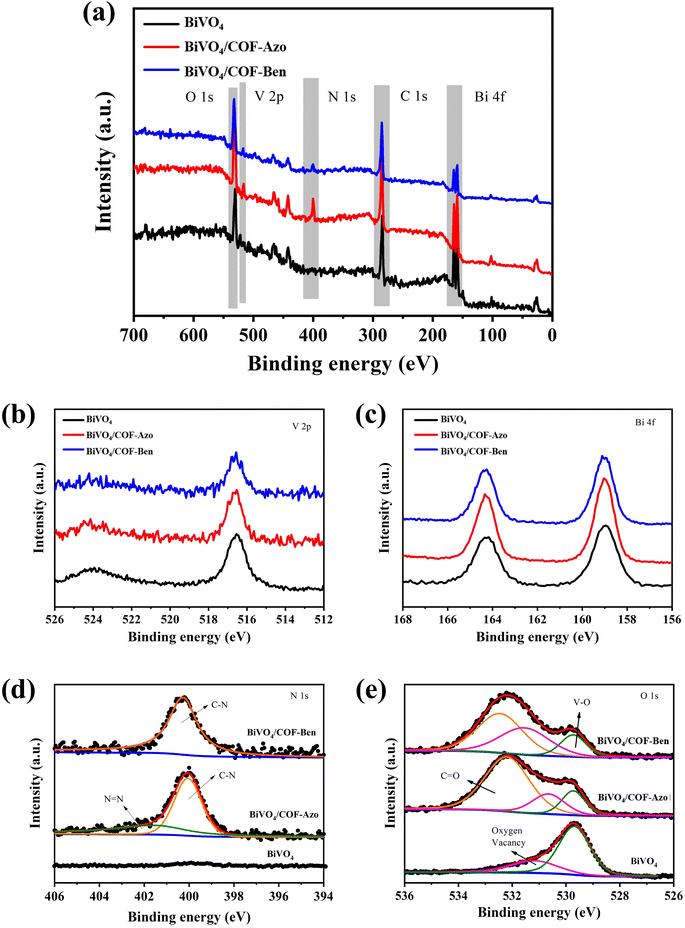 | ||
| Fig. 2 The full survey spectra, (b) V 2p, (c) Bi 4f, (d) N 1s and (e) O 1s high-resolution XPS spectra of BiVO4, BiVO4/COF-Azo and BiVO4/COF-Ben photoanodes. | ||
For photoelectrocatalysis, one of the important factors is the light absorption ability of photoelectric materials. Therefore, the UV-vis diffuse reflectance spectra of BiVO4/COF-Azo and BiVO4/COF-Ben before and after combining were collected (Fig. 3a). It was shown that the absorption wavelength ranges of COF-Azo and COF-Ben were both larger than that of pure BiVO4. Specifically, the absorption range of COF-Azo was 300–700 nm, revealing the strongest absorption ability among them. The maximum absorption edge of pristine BiVO4 photoanode was about 510 nm, while those of BiVO4/COF-Azo and BiVO4/COF-Ben became 650 nm and 600 nm, respectively. Additionally, a shoulder peak was observed in the spectrum of BiVO4/COF-Azo. These changes would greatly improve their absorption ability, thereby enhancing the utilization rate of visible light in a larger wavelength range. Transforming the above spectra by the Tauc plot method, the band gaps of three photoanodes were obtained. As shown in Fig. 3b, the band gap of BiVO4 is 2.53 eV, while that of BiVO4/COF-Azo and BiVO4/COF-Ben is 2.44 eV and 2.48 eV, respectively. The change of band gap indicated that there was interaction between BiVO4 and COFs, which would be beneficial to the conduction of photogenerated carriers so as to increase their photoelectrocatalytic performance. To explore the influence of the specific surface areas on the performance of the photoanode, the specific surface areas of COF-Azo and COF-Ben powders collected from the tube were calculated by nitrogen sorption isotherms at 77 K (Fig. 4). The Brunauer–Emmett–Teller (BET) specific surface areas of COF-Azo powders was calculated to be 151.48 m2 g−1, while that of COF-Ben is 61.61 m2 g−1. The larger BET specific surface area will be more conducive to mass transfer and increase the contact area between photoanode and electrolyte, thereby accelerating the progress of OER.
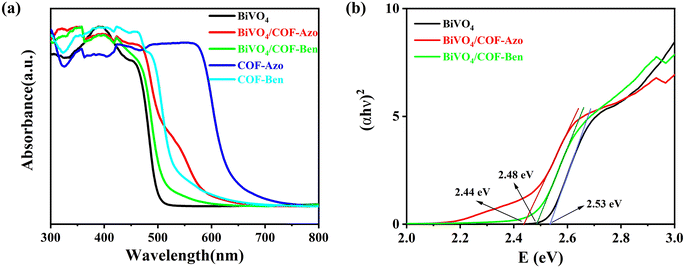 | ||
| Fig. 3 (a) UV-vis diffuse reflectance spectra of BiVO4, COF-Azo, COF-Ben, BiVO4/COF-Azo and BiVO4/COF-Ben photoanodes; (b) Tauc curves of BiVO4, BiVO4/COF-Azo and BiVO4/COF-Ben photoanodes. | ||
Photoelectrochemical performance
The contribution of COF to the photoelectrochemical performance in a water splitting setup was investigated by a series of photoelectrochemical tests. Firstly, the linear sweep voltammetry (LSV) curves that can reflect the water oxidation activity directly were obtained. As shown in Fig. 5a, the pristine BiVO4 exhibited an obvious photocurrent density of 0.82 mA cm−2 at 1.23 V (vs. RHE) and an onset potential of 0.7 V (vs. RHE), indicating that the BiVO4 photoanode could absorb and convert solar energy to catalyze the OER effectively under illumination. It was assumed that the high photocurrent density was attributed to the ordered crystal structure and orientation, which were conducive to the transfer and separation of photo-generated carriers.35 Compared to the pristine BiVO4, both BiVO4/COF-Azo and BiVO4/COF-Ben composite photoanodes showed a higher photocurrent at all potentials. Specifically, the photocurrent density of BiVO4/COF-Azo increased from 0.82 mA cm−2 to 1.38 mA cm−2 at 1.23 V (vs. RHE), while that of BiVO4/COF-Ben only increased to 1.08 mA cm−2 at the same voltage, although their onset potential both negatively shifted to 0.6 V (vs. RHE). The enhanced PEC performance of composite photoanodes demonstrated that the COF species played a positive role in the photoelectrocatalytic water oxidation reaction. Furthermore, the photocurrent transients of the photoanodes were also measured to reflect their photoelectric response performance. The I–t curves showed that the hybrid photoanodes displayed a higher photocurrent density than that of the pristine photoanode, which implied that modifying BiVO4 with COF can improve the photoanode performance effectively (Fig. 5b). To be specific, the photocurrent density of BiVO4/COF-Azo and BiVO4/COF-Ben photoanodes was increased to 1.5 and 1.25 times of BiVO4, respectively, which was consistent with LSV curves. Then, the stability of BiVO4/COF-Azo photoanode with the best performance was evaluated (Fig. S5†). It was found that BiVO4/COF-Azo photoanode exhibited good stability and 80% of the initial catalytic performance could still be maintained after 5 h, which might be related to the high stability of COF-Azo.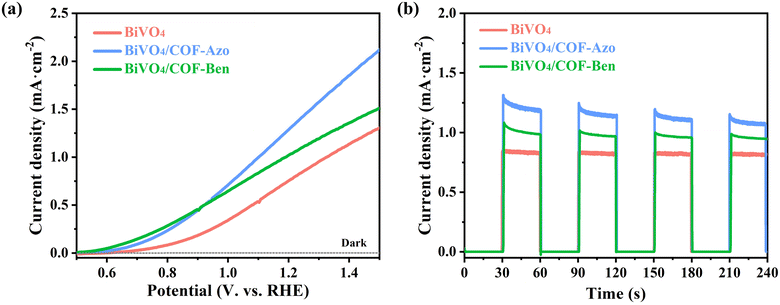 | ||
| Fig. 5 (a) LSV curves and OER curves without illumination; (b) I–t curves of BiVO4, BiVO4/COF-Azo and BiVO4/COF-Ben photoanodes. | ||
In addition, a series of measurements were conducted to explore the exact mechanism. Generally, sulfite oxidation reaction has faster kinetics than OER, so the surface-reaching holes can quickly participate in the oxidation reaction with nearly 100% efficiency. Based on this fact, the ratio of the water oxidation current to sulfite oxidation current can be used to reflect the reaction efficiency of surface-reaching holes.36 As shown in Fig. 6a, it was clear that the BiVO4/COF-Azo and BiVO4/COF-Ben hybrid photoanodes exhibited a higher oxidation current than the pristine one in the presence of Na2SO3, which was speculated that COF could promote the conduction of photogenerated holes to the surface of photoanodes to participate in OER. Compared to BiVO4/COF-Ben, the oxidation current of BiVO4/COF-Azo was higher, indicatingCOF-Azo can accelerate the above conduction process. By calculating the Jwater/Jsurface ratio that was considered as the yield of holes that participate in the water oxidation reaction at the electrolyte/semiconductor interface (ηsurface), the reaction efficiency of the surface-reaching holes was obtained. From Fig. 6b, the composite photoanodes BiVO4/COF-Azo and BiVO4/COF-Ben both showed a much higher reaction efficiency than that of pristine BiVO4 photoanode. It indicated that the surface-reaching holes tended to react with water more quickly and efficiently after the modification with COFs, which further confirmed that the integrated COFs can improve interface properties and boost the water oxidation reaction. The electrochemical impedance spectra (EIS) were also recorded to figure out the transfer of carriers in the PEC system. As presented in Fig. 6c, three curves all exhibited a typical resistance arc, but the smaller radius for the modified photoanode was compared with that for the pure BiVO4 photoanode, which meant that the former possessed a better ability to transfer the carrier. Among them, the resistance arc radius of BiVO4/COF-Azo was the smallest, revealing its minimal charge transfer impedance in the reaction and the best ability to transfer carriers. Thus, it was easiest for BiVO4/COF-Azo to transfer photogenerated holes to the surface of the photoanode, thereby showing the most outstanding OER performance. Considering that the intrinsic properties of the photoanode were unlikely to be changed just by the modification of COFs, the OER curves of two BiVO4/COF and original BiVO4 photoanodes in the absence of illumination were recorded as well, which verified the change of electrocatalytic OER performance after combining COFs (Fig. 6d). It was found that the photocurrent density of BiVO4/COF-Azo and BiVO4/COF-Ben photoanodes was much higher than that of the pristine BiVO4 when voltage was more than 2.0 V (vs. RHE) without illumination. Higher photocurrent density and lower overpotential meant better electrocatalytic performance. Therefore, the two composite photoanodes had higher water oxidation activity and more negative initial potential of oxygen evolution, which made their water oxidation reaction kinetics faster and could make use of the holes reaching the surface of the photoanodes more effectively. At the same time, the curves of BiVO4/COF-Azo and BiVO4/COF-Ben basically coincided, proving that the main difference of their photoelectrocatalytic OER performance came from the influence of light rather than electricity.
Finally, the interaction between BiVO4 and COF was further explored by testing the band structure of photoanodes before and after combination (Fig. 7). It can be inferred from Tauc and M–S diagrams that both COF-Azo and COF-Ben belong to N-type semiconductors with band gaps of 2.02 eV and 2.39 eV, respectively. Concretely, the conduction band position of COF-Azo is about 0.22 V (vs. RHE), so the valence band position is about 2.24 V (vs. RHE); the conduction band position of COF-Ben is about 0.34 V (vs. RHE), so the valence band position is about 2.73 V (vs. RHE); the conduction band position of BiVO4 is about 0.84 V (vs. RHE) and the forbidden bandwidth is 2.53 eV, so the valence band position is about 3.37 V (vs. RHE). According to the above values, the energy band structure diagram was shown in Fig. 7f. It can be seen that the conduction band and valence band of COF-Azo and COF-Ben were higher than those of BiVO4. Therefore, heterojunction can be formed by combination so that the separation efficiency of photogenerated carriers was enhanced and the recombination rate was reduced. As a result, electrons gathered at BiVO4, while holes moved to COFs. It made more photogenerated holes reach the surface of photoanodes to participate in the reaction, which further improved the photoelectrocatalytic OER performance.
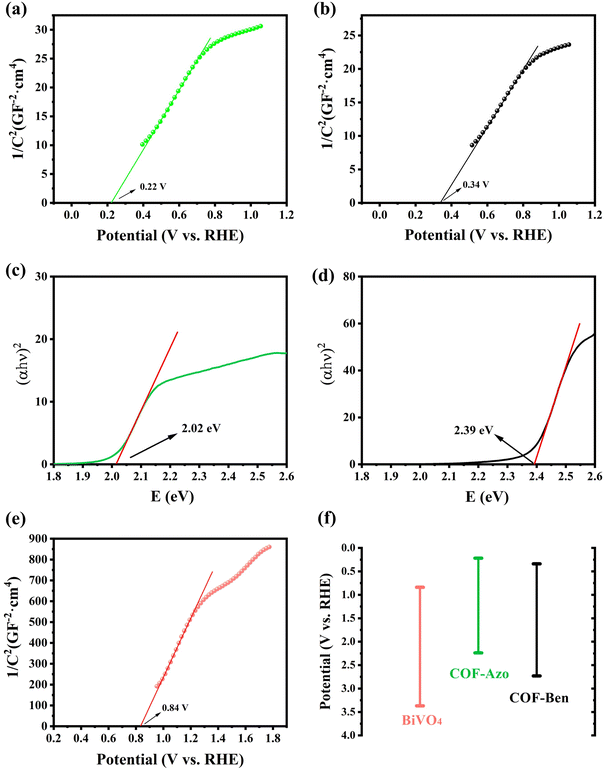 | ||
| Fig. 7 (a) M–S curve of COF-Azo; (b) M–S curve of COF-Ben; (c) Tauc curve of COF-Azo; (d) Tauc curve of COF-Ben; (e) M–S curve of BiVO4; (f) band structure diagram of BiVO4, COF-Azo and COF-Ben. | ||
Conclusion
In summary, two composite photoanodes, BiVO4/COF-Azo and BiVO4/COF-Ben, have been synthesized by in situ growth of COF on BiVO4 via covalent bonding. Comprehensive characterization results including SEM, TEM, FT-IR, XPS and EDS mapping confirmed the successful hybridization of BiVO4 with COF-Azo and COF-Ben, respectively. The experimental results showed that the catalytic performances of two hybrid photoanodes were significantly improved compared with pristine BiVO4. Particularly, the photoelectrocatalytic property of BiVO4/COF-Azo was superior to that of BiVO4/COF-Ben, which might be attributed to its better light absorption ability. Moreover, the mechanism was proposed according to various electrochemical and spectroscopic tests. The suitable energy band structure of COFs could match with BiVO4 well to form heterojunction, which can improve the separation efficiency of photogenerated carriers and inhibit the recombination. In addition, the smaller impedance of the composite photoanodes and faster kinetics of water oxidation reaction kinetics both contributed to the enhancement of OER performance. Thus, this study not only provides a feasible way to design efficient photoanode, but also expands the potential applications of COFs.Author contributions
Anni Guo: conceptualization, investigation, formal analysis, validation, writing – original draft, writing – review & editing. Xingchun Wu: conceptualization, investigation, formal analysis, validation, writing – original draft. Syed Husnain Alia: writing – review & editing. Huawei Shen: writing – review & editing. Bowei Wang: supervision, project administration, writing – review & editing. Yang Li: supervision, project administration. Ligong Chen: supervision, project administration.Conflicts of interest
The authors declare no competing financial interest.Acknowledgements
This work was supported by the Natural Science Foundation of Tianjin (Grant No. 22JCQNJC00230). The authors thank Ying Ha from Analysis and Testing Center of School of Environmental Science and Engineering, Tianjin University for the assistance in measurement.References
- S. Mukherjee, S. Dutta, Y. D. More, S. Fajal and S. K. Ghosh, Dalton Trans., 2021, 50, 17832–17850 RSC.
- D.-G. Wang, T. Qiu, W. Guo, Z. Liang, H. Tabassum, D. Xia and R. Zou, Energy Environ. Sci., 2021, 14, 688–728 RSC.
- R. Fouquet, Nat. Energy, 2016, 1, 16098 CrossRef.
- K. He, G. Chen, G. Zeng, A. Chen, Z. Huang, J. Shi, T. Huang, M. Peng and L. Hu, Appl. Catal., B, 2018, 228, 19–28 CrossRef CAS.
- S. Dutta, S. Let, S. Sharma, D. Mahato and S. K. Ghosh, Chem. Rec., 2021, 21, 1666–1680 CrossRef CAS PubMed.
- S. Dutta, R. F. de Luis, J. Goscianska, A. Demessence, R. Ettlinger and S. Wuttke, Adv. Funct. Mater., 2023, 2304790 CrossRef.
- Y. D. More, S. Mollick, S. Saurabh, S. Fajal, M. Tricarico, S. Dutta, M. M. Shirolkar, W. Mandal, J. C. Tan and S. K. Ghosh, Small, 2024, 20, e2302014 CrossRef PubMed.
- T. Sick, A. G. Hufnagel, J. Kampmann, I. Kondofersky, M. Calik, J. M. Rotter, A. Evans, M. Döblinger, S. Herbert, K. Peters, D. Böhm, P. Knochel, D. D. Medina, D. Fattakhova-Rohlfing and T. Bein, J. Am. Chem. Soc., 2018, 140, 2085–2092 CrossRef CAS PubMed.
- A. Landman, H. Dotan, G. E. Shter, M. Wullenkord, A. Houaijia, A. Maljusch, G. S. Grader and A. Rothschild, Nat. Mater., 2017, 16, 646–651 CrossRef CAS PubMed.
- N. T. Suen, S. F. Hung, Q. Quan, N. Zhang, Y. J. Xu and H. M. Chen, Chem. Soc. Rev., 2017, 46, 337–365 RSC.
- Y. Li, F.-M. Li, X.-Y. Meng, S.-N. Li, J.-H. Zeng and Y. Chen, ACS Catal., 2018, 8, 1913–1920 CrossRef CAS.
- G. Wu, K. L. More, C. M. Johnston and P. Zelenay, Science, 2011, 332, 443–447 CrossRef CAS PubMed.
- K. Zhu, X. Zhu and W. Yang, Angew. Chem., Int. Ed., 2019, 58, 1252–1265 CrossRef CAS PubMed.
- Y. Yu, Z. Zhang, X. Yin, A. Kvit, Q. Liao, Z. Kang, X. Yan, Y. Zhang and X. Wang, Nat. Energy, 2017, 2, 17045 CrossRef CAS.
- Q. Hu, G. Li, X. Liu, B. Zhu, X. Chai, Q. Zhang, J. Liu and C. He, Angew. Chem., Int. Ed., 2019, 58, 4318–4322 CrossRef CAS PubMed.
- J. Zhang, J. Liu, L. Xi, Y. Yu, N. Chen, S. Sun, W. Wang, K. M. Lange and B. Zhang, J. Am. Chem. Soc., 2018, 140, 3876–3879 CrossRef CAS PubMed.
- S. Fajal, S. Dutta and S. K. Ghosh, Mater. Horiz., 2023, 10, 4083–4138 RSC.
- F. Ahmadijokani, A. Ghaffarkhah, H. Molavi, S. Dutta, Y. Lu, S. Wuttke, M. Kamkar, O. J. Rojas and M. Arjmand, Adv. Funct. Mater., 2023, 2305527 CrossRef.
- H. Xu and D. Jiang, Nat. Chem., 2014, 6, 564–566 CrossRef CAS PubMed.
- S. Jin, M. Supur, M. Addicoat, K. Furukawa, L. Chen, T. Nakamura, S. Fukuzumi, S. Irle and D. Jiang, J. Am. Chem. Soc., 2015, 137, 7817–7827 CrossRef CAS PubMed.
- C. Wang, Z. Zhang, Y. Zhu, C. Yang, J. Wu and W. Hu, Adv. Mater., 2022, 34, e2102290 CrossRef PubMed.
- Y. Zhong, W. Dong, S. Ren and L. Li, Adv. Mater., 2024, 36, e2308251 CrossRef PubMed.
- M. Zhang, M. Lu, Z.-L. Lang, J. Liu, M. Liu, J.-N. Chang, L.-Y. Li, L.-J. Shang, M. Wang, S.-L. Li and Y.-Q. Lan, Angew. Chem., Int. Ed., 2020, 59, 6500–6506 CrossRef CAS PubMed.
- S. Wang, P. Chen, Y. Bai, J.-H. Yun, G. Liu and L. Wang, Adv. Mater., 2018, 30, 1800486 CrossRef PubMed.
- X. T. Gao, Z. Q. Bai, S. Zhang, J. C. Liu and Z. H. Li, RSC Adv., 2020, 10, 45067–45075 RSC.
- S. Saxena, A. Verma, K. Asha, N. K. Biswas, A. Banerjee, V. R. Satsangi, R. Shrivastav and S. Dass, Int. J. Hydrogen Energy, 2020, 45, 26746–26757 CrossRef CAS.
- H. S. Park, K. E. Kweon, H. Ye, E. Paek, G. S. Hwang and A. J. Bard, J. Phys. Chem. C, 2011, 115, 17870–17879 CrossRef CAS.
- R. L. Hu, L. X. Meng, J. X. Zhang, X. Wang, S. J. Wu, Z. Wu, R. Zhou, L. Li, D. S. Li and T. Wu, Nanoscale, 2020, 12, 8875–8882 RSC.
- L. J. Wu, L. Wang, J. Zhu, M. Sun, X. H. Liu, P. Schmuki and J. Zhang, J. Mater. Chem. A, 2020, 8, 2563–2570 RSC.
- G. Z. Fang, Z. F. Liu, C. C. Han, P. Wang, X. G. Ma, H. Lv, C. Y. Huang, Z. W. Cheng and Z. F. Tong, ACS Appl. Energy Mater., 2021, 4, 3842–3850 CrossRef CAS.
- S. Bai, J. Han, Y. Zhao, H. Chu, S. Wei, J. Sun, L. Sun, R. Luo, D. Li and A. Chen, Renewable Energy, 2020, 148, 380–387 CrossRef CAS.
- F. Chen, Q. Yang, J. Sun, F. Yao, S. Wang, Y. Wang, X. Wang, X. Li, C. Niu, D. Wang and G. Zeng, ACS Appl. Mater. Interfaces, 2016, 8, 32887–32900 CrossRef CAS PubMed.
- B. Zhang, S.-Y. Zhao, H.-H. Wang, T.-J. Zhao, Y.-X. Liu, L.-B. Lv, X. Wei, X.-H. Li and J.-S. Chen, Chem. Commun., 2017, 53, 10544–10547 RSC.
- B. Gao, T. Wang, X. Fan, H. Gong, X. Meng, P. Li, Y. Feng, X. Huang, J. He and J. Ye, Sol. RRL, 2018, 2, 1800102 CrossRef.
- C. W. Kim, Y. S. Son, M. J. Kang, D. Y. Kim and Y. S. Kang, Adv. Energy Mater., 2016, 6, 1501754 CrossRef.
- T. W. Kim and K.-S. Choi, Science, 2014, 343, 990–994 CrossRef CAS PubMed.
Footnotes |
| † Electronic supplementary information (ESI) available. See DOI: https://doi.org/10.1039/d4ra00899e |
| ‡ These authors contributed equally to this work. |
| This journal is © The Royal Society of Chemistry 2024 |


